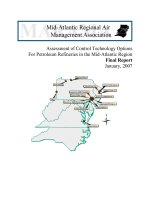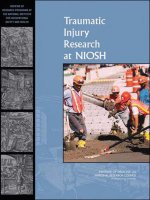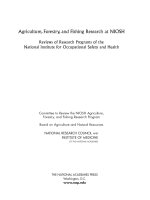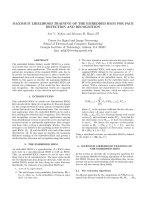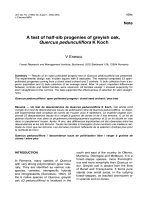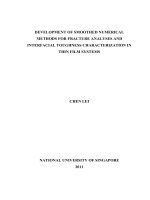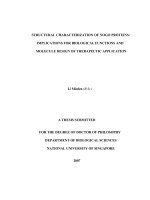Assessment of variability in half Sib progenies of Grewia optiva Drummond for various qualitative and quantitative traits in north western Himalayas
Bạn đang xem bản rút gọn của tài liệu. Xem và tải ngay bản đầy đủ của tài liệu tại đây (345.13 KB, 9 trang )
Int.J.Curr.Microbiol.App.Sci (2019) 8(4): 1661-1669
International Journal of Current Microbiology and Applied Sciences
ISSN: 2319-7706 Volume 8 Number 04 (2019)
Journal homepage:
Original Research Article
/>
Assessment of Variability in Half Sib Progenies of Grewia optiva
Drummond for Various Qualitative and Quantitative Traits in
North Western Himalayas
Shikha Bhagta1*, H.P. Sankhyan1, J.P. Sharma1 and Reena Kumari2
1
Department of Tree Improvement and Genetic Resources, Dr YS Parmar University of
Horticulture and Forestry, Nauni-173 230, Solan, HP, India
2
Department of Vegetable Science, Dr YS Parmar University of Horticulture and Forestry,
Nauni-173 230, Solan, HP, India
*Corresponding author
ABSTRACT
Keywords
Half sib families,
Grewia optiva
Drummond,
morphometric,
Fodder quality traits
Article Info
Accepted:
12 March 2019
Available Online:
10 April 2019
To assess the mean performance and extent of genetic variability, 40 half sib
progenies of Grewia optiva Drummnond were evaluated in randomized complete
block design with three replications. The observations were recorded on various
morphometeric and fodder quality parameters. The analysis of variance indicated
highly significant differences among the various half sib families for all the traits
studied. The experimental results revealed that out of 40 families ten families viz.
SI-15, SO-3, HA-2, HA-3, HA-4, SO-7, SH-7, SO-4, SI-6 and SI-14 were found
superior on the basis of overall mean performance for all quantitative and
qualitative traits under study. Hence, these half sib families can be used in further
breeding programme.
Introduction
Livestock plays an important role in mountain
farming systems and Himachal Pradesh is one
of the important livestock rearing states in
India. In this state, mixed agricultural
production system is practiced by the farmers
with both crop and livestock husbandry as the
important components. Availability of
nutritious fodder is the biggest constraint in
animal husbandry in this state. Except for
rainy season (July to September), there is
scarcity of fodder throughout the year. In hilly
and mountain regions, the demand of feeds
and fodder for livestock is much higher than
their availability (Singh and Bimal, 2004).
Grewia optiva is one of the most important
tree species used as fodder in Himachal
Pradesh (Singh, 2005). It belongs to family
Tiliaceae and naturally distributed in India,
Bhutan, Nepal, and Pakistan. In India it is
distributed in areas of Himachal Pradesh,
Jammu and Kashmir, Punjab, Sikkim and
Uttar Pradesh (Hooker, 1875). Several species
of Grewia are used as a very important
multipurpose or agro forestry tree, of
1661
Int.J.Curr.Microbiol.App.Sci (2019) 8(4): 1661-1669
which Grewia optiva, commonly known as
‘Beul’, having chromosome number 2n=18
(Coleman, 1982) and very popular
agroforestry tree which is grown in low and
mid-hills regions in the western and central
Himalaya on account of its utility as fodder,
fuel and fibre. Flowers appear with the new
flush of leave and it flowers from the end of
March to June; flowers are monoecious and
lemon yellow in color. Greater the diversity in
material, more the chances of getting the
desired types. This variation, can be utilized
for breeding purposes for some useful traits
like fodder value, growth rate and for
conservation of species. With the increase in
demand for fodder, there is a need to develop
clones of genetically superior trees.
Therefore, it is essential to understand the
genetic architecture of Grewia optiva, which
provides useful guidelines to determine the
source population and from which it is
possible to derive appropriate genotypes with
desired characters. The study of variability for
various characters is pre-requisite for a plant
breeder to develop a high yielding variety
with good quality. Therefore, evaluating
locally adopted beul families for commercial
cultivation is priority area of research in
improving the fodder quality.
families are selected and were evaluated for
various morphometric and fodder quality
parameters and recorded observations on
various morphometric parameters viz. plant
height (m), plant diameter (cm), number of
leaves, leaf area (cm2), leaf fresh weight (g),
leaf dry weight (g), leaf dry matter content
(%), fodder yield (kg), total fresh leaf biomass
(g) and fodder quality parameters of families
viz., ether extract (%), crude fibre (%), crude
protein (%), total ash (%) and nitrogen free
extract (%). Data has been analyzed
statistically as per the method suggested by
Panse and Sukhatme (1967) and chandel
(1984). The table for analysis of variance
(ANOVA) was set as explained by Gomez
and Gomez (1983).
Results and Discussion
The analysis of variance indicated highly
significant differences among the families for
all the morphometric traits and fodder quality
traits studied, which revealed the existence of
good deal of variability in the seedling seed
orchard of Grewia optiva. The mean
performance of all the families (Table 2 and
3), general mean value, range and coefficient
of variance (Table 4 and 5) for various traits
under study is described below:
Materials and Methods
Morphometric traits
Present investigation has been carried out in
the Experimental Research Farm of the
Department of Tree Improvement and Genetic
Resources, College of Forestry, Dr YS
Parmar University of Horticulture and
Forestry, Nauni, Solan (Himachal Pradesh). A
seedling seed orchard of Grewia optiva
Drummond has been established in July 2000,
which consists of 60 families each under three
replications at spacing of 2m × 2m. These
different families have been sourced from
various districts of Himachal Pradesh which
include Sirmour, Solan, Chamba, Bilaspur,
Mandi, Hamirpur and Kangra (Table 1). For
the present study out of 60 families only 40
Significant variations were obtained among
all the families for plant height (Table 2).
Plant height ranged from 4.67 - 9.20 m (Table
4). General mean for the character was 7.04
m. Family SO-1 show highest plant height
and it was found statistically at par with seven
other families viz., BI-3, HA-2, SH-2, SI-7,
SI-10, SO-1, SO-7 and SO-12. Plant diameter
ranged from 9.94- 16.19 cm with general
mean value of 12.16 cm. Family HA-4
recorded maximum diameter and found
statically at par with nine families viz., BI-4,
CH-4, HA-2, HA-4, SH-2, SI-7, SI-10, SO-1
and SO-12. Family SI-4 showed minimum
1662
Int.J.Curr.Microbiol.App.Sci (2019) 8(4): 1661-1669
value for diameter. Number of leaves is a
major yield contributing trait in Grewia
optiva. All the families’ studies revealed
significant variations for this character. It
ranged from 3634.3 - 1687.6. Family with
mean value of 2718.95. Maximum number of
leaves per plant was observed in family SH-3
and it was statistically at par with 12 other
families viz. CH-4, CH-6, HA-2, HA-4, KA3, SH-3, SH-7, SI-4, SI-6, SI-10, SI-15 and
SO-7. Minimum number of leaves per plant
was observed in BI-1. A perusal of data
(Table 2) revealed that the differences in leaf
area were significant among the different
families. It ranged from 77.22 - 40.84.
General mean for the character was 58.25
(Table 4). Family SH-7 recorded the
maximum leaf area of while the minimum
leaf area was recorded in BI-1. Families CH1, HA-3, HA-4, MA-2, SH-7, SI-10, SI-15,
SO-3, SO-4, and SO-7 were at par with the
maximum. Fresh weight of 100 leaves (g)
ranged from 48.16 - 87.00 in families SO-4
and BI-3 respectively. General mean for the
character was 64.57.Families CH-1, HA-3,
HA-4, MA-2, SH-7, SI-10, SI-15, SO-3, SO-4
and SO-7 were statistically at par with the
maximum. Dry weight of 100 leaves (g)
ranged from 25.16 -50.33 (g). General mean
of 33.71 was recorded for this character.
Maximum dry weight of 100 leaves was
recorded in HA-3 and it was found
statistically at par with CH-1, HA-3, HA-4,
MA-2, SH-7, SI-10, SI-15, SO-3, SO-4 and
SO-7. Minimum dry weight of 100 leaves is
recorded for family BI-3. Appraisal of the
data (Table 2) elucidated that SO-8 attained
the maximum (55.56 %) leaf dry matter
content. HA-3 showed the lowest leaf dry
matter content (41.22 %). General mean for
the character was 48.19 percent (Table 4).
Appraisal of the data presented in table 2
elucidated that HA-3 attained the maximum
fodder yield (13.81 kg) followed by SO-3,
SO-5, SO-9, S0-4 and SO-7 and SI-15
respectively. Minimum (8.84) was observed
for family BI-1. As clearly indicated in Table
2, total fresh leaf biomass (g) exhibited
significant differences among families.
Maximum total fresh leaf biomass was
observed in family SH-7 (3024.97g), whereas
the minimum was recorded in family BI-1
(893.36g). Family SI-15 and SO-7 found
statically at par with maximum. General mean
was 1770.81 g for the character. Wide range
of variation for different morphometric traits
recorded by Sehgal and Jaswal (1996)
Rathore (1997) in Grewia optiva, Bhat (1999)
in Albizia lebbek and Choudhary (2000) in
Toona ciliata, Pant et al., (2003) in Grewia
optiva; Wani et al., (2009) in Bauhinia
variegata and Sankhyan et al., (2009) in
Grewia laevigata. Similar variations were
reported with respect to leaf dimensions and
leaf area by Wani et al., (2009) in Bauhinia
variegata, Sankhyan et al., (2009) in Grewia
laevigata, Bhat (2010) in Grewia optiva,
Bhagta (2015) in Grewia optiva and
Sankhyan et al., (2016) in Grewia optiva lend
support to the present findings.
Fodder quality traits
Crude protein is one of the most important
constituents of fodder quality particularly for
the growing demand of meat producing
animals, as it contains the muscle building
fraction of the diet. It is generally used as an
index of nutritive value. Among 40 families
crude protein ranged from 18.09 -22.11 per
cent (Table 5). The maximum of crude
protein (22.10 %) was observed in family
HA-2 and the minimum in family MA-2
(Table 3) followed by family CH-3, HA-2, SI11, SI-14, SI-16, SO-3, SO-8, SO-9 and SO10. The crude fibre was observed in family
HA-2 (21.84 %) whereas the minimum was
recorded in family SI-11 (18.58%). Thirteen
families viz. CH-1, CH-3, HA-2, HA-4, SH-7,
SI-3, SI-7, SI-14, SI-15, SO-1, SO-4, SO-7
and SO-10 found statically at par with
maximum. General mean was 20.52 for crude
1663
Int.J.Curr.Microbiol.App.Sci (2019) 8(4): 1661-1669
fibre (Table 5). Highest value of ether extract
content was recorded for family MA-3 (5.88
%) which was closely followed by CH-1, CH3, CH-6, HA-3, KA-3MA-3, SI-15, SI-16,
SO-1, SO-2, SO-3 and SO-7. However,
lowest value was recorded for family SH-3
(8.80 %). General mean was 5.34 for the
character. Total ash ranged from 13.13 - 10.7
percent. General mean for this trait was 11.96.
Eighteen families recorded higher total ash
content than population mean. Maximum
(13.13 %) total ash content was recorded in
family S0-12, and was statistically at par with
families CH-1, HA-2, SI-11, SI-14, SI-16 and
SO-12. Significant differences were observed
with respect to nitrogen free extract (%) in all
the families studied. It ranged from 38.3744.25 per cent. General mean for the character
was 41.18. Maximum nitrogen free extract
(44.25 %) was observed in family HA-3
whereas minimum (38.37 %) was noticed in
family SH-7. Presence of tremendous genetic
variation was also reported by Kaushal (1978)
in proximate principles and mineral nutrients
in Grewia optiva; Rathore (1997) in Grewia
optiva; Gera et al., (2002) in Dalbergia sisso;
Wani et al., (2009) in Bauhinia variegata and
Sankhyan et al., (2009) in Grewia laevigata,
Bhat (2010), Bhagta (2015) and Sankhyan et
al., (2016) in Grewia optiva lend support to
the present findings.
Table.1 Families selected in established open pollinated seedling seed orchard of Grewia optiva
Sr. No.
1
2
3
4
5
6
7
8
9
10
District
Bilaspur
Bilaspur
Bilaspur
Chamba
Chamba
Chamba
Chamba
Hamirpur
Hamirpur
Hamirpur
11
12
13
14
15
16
17
18
19
20
Hamirpur
Kangra
Kangra
Kangra
Mandi
Mandi
Shimla
Shimla
Shimla
Sirmour
Family
Bilaspur
Auhar
Kuthira
Chanad
Balu
Audhpur
Saru
Patta Balakhar
Bassi
Hamirpur
Kanal
Ghahar
Dharamshala
Bhalun
Varal
Bachhwan
Bambla
Ninmun
Jeury
Taradevi
Deothal
Code
UHF- BI-1
UHF- BI-3
UHF -BI-4
UHF -CH-1
UHF -CH-3
UHF -CH-4
UHF -CH-6
UHF -HA-2
UHF -HA-3
UHF -HA-4
Sr. No
21
22
23
24
25
26
27
28
29
30
District
Sirmour
Sirmour
Sirmour
Sirmour
Sirmour
Sirmour
Sirmour
Sirmour
Sirmour
Sirmour
Family
Dilman
Deyoltikkeri
Kalaghat
Nandel
Seenaghat
Adgu
Sarpadol
Saraha Chakli
Madhobag
Nainatikker
Code
UHF -SI-4
UHF SI-5
UHF -SI-6
UHF -SI-7
UHF -SI-10
UHF -SI-11
UHF -SI-13
UHF -SI-14
UHF -SI-15
UHF -SI-16
UHF -HA-5
UHF -KA-1
UHF -KA-2
UHF -KA-3
UHF -MA-2
UHF -MA-3
UHF -SH-2
UHF -SH-3
UHF -SH-7
UHF -SI-3
31
32
33
34
35
36
37
38
39
40
Solan
Solan
Solan
Solan
Solan
Solan
Solan
Solan
Solan
Solan
Gaura
Nauni
Dharja
Deog
Badhlech
Oyali
Kailar
Deothi
Jaunaji
Kasholi
UHF -SO-1
UHF -SO-2
UHF -SO-3
UHF -SO-4
UHF -SO-5
UHF -SO-7
UHF -SO-8
UHF -SO-9
UHF -SO-10
UHF -SO-12
1664
Int.J.Curr.Microbiol.App.Sci (2019) 8(4): 1661-1669
Table.2 Variation in mean performance for morphometric traits among different families of Grewia optiva
Sr.
No.
Family
Height
(m)
Diameter
(cm)
Leaf
area
2
(cm )
Estimated
number of
leaves
Fresh
weight of
100 leaves
(g)
Dry weight
of 100
leaves (g)
Leaf dry
matter
content
(%)
Fodder yield
(Kg)
Total fresh
leaf
biomass (g)
1
BI -1
7.00
11.57
40.84
1687.6
52.90
27.33
48.38
8.84
893.36
2
BI-3
8.00
11.38
52.44
2231.0
48.16
25.16
47.10
10.29
1074.60
3
BI-4
6.33
13.90
48.43
1989.3
49.07
25.33
48.24
10.33
976.10
4
CH-1
5.76
11.31
68.85
2267.7
76.50
43.83
42.69
10.49
1734.77
5
CH-3
7.46
12.01
56.92
2660.7
65.33
36.67
43.83
11.85
1738.30
6
CH-4
7.17
14.28
45.29
3351.7
52.84
27.67
47.61
9.58
1771.02
7
CH-6
6.33
10.22
63.57
3016.3
59.02
28.67
51.37
9.61
1780.24
8
HA-2
9.10
14.39
65.89
3050.7
73.47
27.50
50.68
9.98
1698.20
9
HA-3
7.00
11.47
75.30
2738.3
86.17
50.33
41.22
13.81
2359.53
10
HA-4
7.50
16.19
73.85
3123.0
77.17
43.17
43.88
12.42
2409.92
11
HA-5
6.50
10.32
48.57
2332.0
53.17
27.17
48.60
8.99
1239.85
12
KA-1
6.67
11.00
53.51
2559.3
62.43
32.17
47.90
10.27
1597.88
13
KA-2
6.83
11.34
57.93
2514.7
64.33
31.67
50.71
10.27
1617.77
14
KA-3
6.67
11.85
56.33
3187.7
61.33
30.83
49.60
9.94
1955.10
15
MA-2
6.67
11.82
66.20
2721.7
72.17
38.83
46.98
11.40
1964.14
16
MA-3
6.00
10.51
55.54
2807.3
62.50
33.83
46.76
10.81
1754.58
17
SH-2
7.53
14.79
59.12
2423.3
56.33
27.17
51.44
9.69
1365.14
18
SH-3
7.50
11.50
55.61
3634.3
70.00
39.83
42.86
11.66
2544.03
19
SH-7
7.50
11.53
77.22
3521.0
86.17
48.50
43.84
13.10
3024.97
1665
Int.J.Curr.Microbiol.App.Sci (2019) 8(4): 1661-1669
20
SI-3
7.17
10.91
48.93
2366.0
54.50
26.83
50.83
10.05
1289.47
21
SI-4
5.84
9.94
51.97
2920.7
61.17
30.17
50.31
10.75
1786.47
22
SI-5
4.67
10.60
60.89
2760.0
61.50
28.83
53.19
10.36
1697.40
23
SI-6
7.17
11.45
58.95
3320.3
70.83
32.83
53.71
11.39
2351.90
24
SI-7
8.67
13.78
62.87
2793.0
71.50
39.00
46.02
12.35
1997.00
25
SI-10
8.63
13.87
65.29
2902.0
78.17
42.67
45.81
13.32
2268.40
26
SI-11
7.00
11.61
53.93
2470.3
59.33
32.50
45.00
10.87
1465.73
27
SI-13
7.50
12.24
59.88
2092.7
65.83
34.83
47.08
11.60
1377.67
28
SI-14
7.50
12.95
62.96
2509.7
68.33
34.67
49.17
12.46
1714.94
29
SI-15
7.17
12.40
66.00
3623.7
73.77
39.67
46.38
13.39
2673.06
30
SI-16
6.83
11.80
47.19
2810.3
49.00
25.50
47.76
9.41
1377.06
31
SO-1
9.20
13.45
49.51
3094.0
54.40
28.67
46.88
11.19
1683.14
32
SO-2
7.17
11.66
48.55
2535.3
64.10
31.67
50.60
11.11
1625.15
33
SO-3
6.17
12.49
66.35
2426.7
77.33
41.33
47.01
13.74
1876.62
34
SO-4
6.67
11.31
75.93
2392.0
87.00
46.00
47.46
13.45
2081.04
35
SO-5
6.00
10.35
50.22
2808.3
56.53
26.17
53.73
13.74
1587.64
36
SO-7
7.83
12.80
69.23
3402.3
77.43
41.83
46.50
13.45
2634.54
37
SO-8
6.50
12.87
53.79
2728.0
57.52
25.83
55.56
10.02
1569.15
38
SO-9
6.50
12.17
56.41
2254.0
66.05
34.83
47.60
13.50
1488.84
39
SO-10
6.00
10.72
56.34
2309.0
62.33
31.50
50.06
9.56
1439.28
40
SO-12
8.17
15.75
53.78
2422.0
55.00
27.47
50.07
10.94
1332.10
1.67
3.10
12.14
743.98
15.30
10.27
2.40
373.46
4.95
C.D (0.05)
1666
Int.J.Curr.Microbiol.App.Sci (2019) 8(4): 1661-1669
Table.3 Variation in mean performance for fodder quality parameters among different families
of Grewia optiva
Sr. No.
1
2
3
4
5
6
7
8
9
10
11
12
13
14
15
16
17
18
19
20
21
22
23
24
25
26
27
28
29
30
31
32
33
34
35
36
37
38
39
40
C.D(0.05)
Family
code
BI -1
BI-3
BI-4
CH-1
CH-3
CH-4
CH-6
HA-2
HA-3
HA-4
HA-5
KA-1
KA-2
KA-3
MA-2
MA-3
SH-2
SH-3
SH-7
SI-3
SI-4
SI-5
SI-6
SI-7
SI-10
SI-11
SI-13
SI-14
SI-15
SI-16
SO-1
SO-2
SO-3
SO-4
SO-5
SO-7
SO-8
SO-9
SO-10
SO-12
Crude protein
(%)
20.46
20.60
20.65
20.56
21.97
19.85
21.63
22.11
18.85
21.03
19.57
19.53
19.84
20.31
18.09
19.93
18.98
20.03
19.84
19.98
21.59
21.47
21.64
20.66
21.58
21.73
19.69
21.67
21.57
21.64
21.30
20.57
21.89
21.07
20.57
21.46
21.74
21.71
21.86
20.68
0.28
Crude fiber
(%)
20.54
20.18
20.52
21.81
21.40
20.86
18.73
21.84
19.30
21.68
19.24
20.92
20.17
19.68
20.96
19.73
19.30
19.29
21.43
21.33
18.78
21.00
18.87
21.32
20.31
18.59
19.44
21.44
21.64
21.07
21.35
19.77
19.84
21.65
21.23
21.34
21.13
20.72
21.76
20.86
0.58
1667
Ether extract
(%)
4.85
5.56
5.06
5.62
5.82
4.83
5.72
4.87
5.80
5.55
5.30
4.96
5.04
5.71
5.51
5.88
5.26
4.65
5.10
5.20
5.62
5.35
5.56
5.10
5.31
5.54
5.25
4.97
5.84
5.86
5.77
5.71
5.78
5.08
5.21
5.81
4.90
4.82
4.84
5.25
0.46
Total ash (%)
12.09
12.31
12.14
13.09
11.84
11.92
12.37
11.34
11.80
12.85
12.46
12.17
10.93
12.55
13.03
12.66
12.69
12.95
15.26
12.66
11.96
11.38
11.83
11.85
11.95
11.90
12.82
10.74
10.84
11.49
11.76
10.82
11.47
10.90
12.23
11.43
11.35
11.25
11.72
13.13
0.41
N.F.E
(%)
42.06
41.35
41.63
38.92
38.97
42.54
41.55
39.84
44.25
38.89
43.43
42.42
44.02
41.75
42.41
41.80
43.77
43.08
38.37
40.83
42.05
40.80
42.10
41.07
40.85
42.24
42.80
41.18
40.11
39.94
39.82
43.13
41.02
41.30
40.76
39.96
40.88
41.50
39.82
40.08
0.82
Int.J.Curr.Microbiol.App.Sci (2019) 8(4): 1661-1669
Table.4 General mean, range and coefficient of variance (C.V.) of morphometric and leaf
parameters among different families of Grewia optiva
Sr. No.
1
2
3
4
5
6
7
8
9
Parameter
Mean
Range
C.V.
7.04
12.16
58.25
4.67-9.20
9.94-16.19
40.84-77.22
14.62
12.16
58.25
2718.95
64.57
1687.66-3634.33
48.16-87.00
16.83
64.57
33.71
48.19
11.10
1770.81
25.16-50.33
41.22-55.56
8.84-13.81
893.36-3024.97
33.71
48.19
13.29
12.97
Height (m)
Diameter (cm)
2
Leaf area(cm )
Estimated number of leaves
Fresh weight of 100 leaves
(g)
Dry weight of 100 leaves (g)
Leaf dry matter content (%)
Fodder yield (kg)
Total fresh green leaf
biomass (g)
Table.5 General mean, range, standard deviation (S.D.) and coefficient of variance (C.V.) of
Proximate fodder analysis among different families of Grewia optiva
Sr. No.
Parameter
Mean
Range
C.V.
1
2
3
4
5
Crude protein (%)
Crude fibre (%)
Ether extract (%)
Total ash (%)
NFE (%)
20.74
20.52
5.34
11.97
41.18
18.09-22.11
18.58-21.83
4.65-5.88
10.74-13.13
38.37-44-25
1.36
1.74
3.22
2.05
1.19
On the basis of mean performance, it is
concluded that half sib families SI-15, SO-3,
HA-2, HA-3, HA-4, SO-7, SH-7, SO-4, SI-6
and SI-14 excelled well for most of the
morphometric and fodder quality traits. These
half sib families can further be used in the
breeding programme. The higher amount of
variation among the different families can be
used to improve the quality of livestock,
through better quality and more fodder to
check their alarming pressure on forest wealth
of Western Himalayas, especially during the
lean winter season.
References
Bhat, G.S. 1999. Provenance variation in seed
and seedling traits of Albizia lebbek
Benth. M.Sc. Thesis. Dr Y.S. Parmar
University of Horticulture and
Forestry, Nauni-Solan (H.P.) 88 p.
Bhagta, S. 2015. Progeny evaluation of open
pollinated seedling seed orchard of
Grewia
optiva
Drummond.
Department of Tree Improvement and
Genetic Resources, Dr. Yashwant
Singh
Parmar
University
of
Horticulture and forestry, Nauni.
1668
Int.J.Curr.Microbiol.App.Sci (2019) 8(4): 1661-1669
p.108.
Bhat, S Saleem. 2010, Evaluation of
established open pollinated Seedling
seed orchard of Grewia optiva
Drummond. Department of Tree
Improvement and Genetic Resources,
Dr.
Yashwant
Singh
Parmar
University of Horiculture and forestry,
Nauni. p.89.
Choudhary, P. 2000. Studies on genetic
variation in open-pollinated families
of Toona ciliata. M.Sc. Thesis. Dr.
Y.S.
Parmar
University
of
Horticulture and Forestry, Nauni,
Solan 73 p
Coleman, 1982. Chromosome numbers of
angiosperms collected in the state of
Sao Paulo. Brazilian Journal of
Genetics , 5(3): 533-549.
Gera, M, Gera N, Aggarwal R and Gpta B N.
2002. Genetic variation in biochemical
contents in foliage of twenty seed
sources of Dalbergia sissoo. Ind. For.
128(7):726-737.
Hooker, JD. 1875. Flora of British India L.
Revve & Co., London.
Pant, K S, Prabhakar M and Panwar P. 2003.
Floral biology of Grewia optiva
Drummond. Annals of Plant and Soil
Research 5(10): 61-69.
Kaushal, P S. 1978. Screening of beul trees
(Grewia
optiva)
for
superior
nutritative stains Msc.
Thesis
H.P.U.64
Rathore, Amandeep. 1997. Evaluation of
selected genotypes of Grewia optiva.
M.Sc.Thesis
Dr.
Y.S.
Parmar
University of Horticulture and
Forestry, Nauni-Solan (H.P.) 55 p.
Singh, R. 2005. Survey of socio-economic
profile of farmers and animal feed
resources in the mountains of
Himachal
Pradesh.
Himalayan
Ecology 13(2): 12-15.
Singh, R and Bimal M. 2004. Traditional
animal rearing practices in mountains
of Himachal Pradesh. ENVIS Bulletin
12(1): Himalayan Ecology
Sehgal, R N and Jaswal S. 1996. Seed source
variation on Grewia optiva. In: Proc.
QFRI-IUFRO conference on tree
improvement for sustainable tropical
Forestry Caloundra, Australia 27
October to November 1996
Sankhyan, H P, Bawa R and Mariappan N.
2009. Fodder quality evaluation of
Grewia laevigata Vahl: a lesser
known tree species of Shiwaliks. Ind.
For. 135(3): 347-360.
H.P. Sankhyan and Shikha Bhagta, 2016,
fodder quality analysis of open
pollinated seedling seed orchard of
Grewia Optiva Drumond, The Bioscan
11(2):709-713.
Wani, A M, Raj A J and Chauhan.2009.
Association
analysis
for
morphological and biomass traits in
Bauhinia variegata seedlings. Ind. J.
Trop. Biodiv. 16(1): 61-70.
How to cite this article:
Shikha Bhagta, H.P. Sankhyan, J.P. Sharma and Reena Kumari. 2019. Assessment of
Variability in Half Sib Progenies of Grewia optiva Drummond for Various Qualitative and
Quantitative Traits in North Western Himalayas. Int.J.Curr.Microbiol.App.Sci. 8(04): 16611669. doi: />
1669
